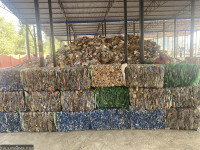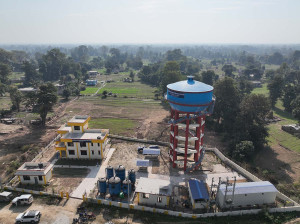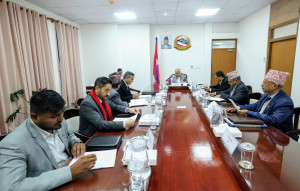Money
Private sector has mixed reactions to 2025–26 budget
Businesses and enterprises welcome supportive measures of the federal budget but criticise the lack of clarity, regional focus, and spending viability.
Post Report
The private sector has given a mixed response to the federal budget for fiscal year 2025–26, presented by Finance Minister Bishnu Paudel at the Federal Parliament on Thursday. The government unveiled a Rs1.96 trillion budget, which is 5.6 percent larger than the current fiscal year's financial plan.
In Koshi province, business leaders expressed disappointment over the federal government’s continued disregard for Biratnagar's and the province's long-term development needs.
While the budget includes provisions to promote agriculture, boost rice production, support startups and information technology, expand tourism and exports, and improve urban infrastructure, industrialists argue that Koshi’s broader development priorities remain unaddressed.
Rajendra Raut, president of the Federation of Nepalese Chambers of Commerce and Industry, Koshi, welcomed the government’s emphasis on increasing spring paddy production and achieving rice self-sufficiency, calling it a step toward agricultural self-reliance.
He also praised several business-friendly measures, including loans at 3 percent interest for youth entrepreneurs, a five-year income tax exemption for large startups, the removal of the requirement to deposit bank guarantees for EXIM Codes, the elimination of advance income tax on imported food grains, and tax and electricity tariff exemptions in the IT and hospitality sectors.
“Had the budget been crafted based on Biratnagar’s potential, it could have significantly uplifted the economic activities in the eastern region,” said Raut. “Unfortunately, the region’s priorities have once again been overlooked.”
Similarly, Pawan Kumar Sharda, president of the Confederation of Nepalese Industries, Koshi, noted that although the budget is silent on long-standing proposals such as the construction of an exhibition centre, a special economic zone (SEZ), and the upgrading of the regional airport, the allocation of subsidies to sectors like agriculture and IT is a positive move.
In Sudurpaschim province, private sector representatives voiced frustration at the lack of detailed allocations for major infrastructure projects. While the government outlined ambitious development goals, most lacked clear budget figures, leading to doubts about their implementation.
For instance, the budget references the Shaheed Dasharath Chand University of Health Sciences in Geta, Kailali—a highly anticipated project—but fails to specify its allocation. Likewise, no financial figures are mentioned while it includes the Dhangadhi–Khutia–Bipinagar–Dipayal Expressway, intended to link the Far West’s hilly districts to the Tarai.
Other key initiatives followed a similar pattern: upgrading the Attariya–Khodpe–Darchula road to a double lane, upgrading the Brahmadev–Jhulaghat–Tusarpani section, and opening the Tusarpani–Tinkar track under the Mahakali Corridor. The planned improvements to the Gaddachauki–Attariya section of the East–West Highway were also announced without a budget.
Although the Karnali Multipurpose Project is set for detailed study, and construction is planned for a 400 kV cross-border transmission line from Dodhara to Bareilly, India, and a 220 kV line from Chameliya to Joljibi, financial specifics were again omitted.
The government also announced plans to complete the Ranijamara–Kulariya and Mahakali Irrigation projects within three years and to conduct a feasibility study for an airport in Dadeldhura.
Budget allocations for other key initiatives—such as a medical college and Fapla Cricket Stadium in Dhangadhi, a modern industrial zone in Daiji, Kanchanpur, a dry port in Dodhara Chandani, and tourism infrastructure in Shuklaphanta and Khaptad national parks—were mentioned without funding details.
“This lack of transparency has cast doubt on the priority and feasibility of these projects,” said Pushkar Ojha, senior vice-president of the Kailali Chamber of Commerce and Industry.
In Lumbini province, business leaders offered a more optimistic outlook.
Hari Prasad Aryal, president of the Butwal Chamber of Commerce and Industry, said the budget reflects concerns raised by the local business community.
He cited the planned construction of Butwal Medical College, investments in Karshaghat agriculture, and a 50 percent rent discount for industries in industrial zones as encouraging steps. “The main issue now is the government’s capacity to spend the development budget,” Aryal said.
Tanka Prasad Pokharel, president of the Nepal Chamber of Commerce in Lumbini, echoed the sentiment, highlighting the inclusion of several industry proposals. The removal of the EXIM Code requirement and the decision not to raise revenue rates were welcomed.
However, Pokharel questioned the government’s ability to finance and execute the proposed plans.
“If funding sources are uncertain, internal discontent will rise,” he warned. “That said, the budget does send a generally positive message to the private sector.”
In Madhesh province, industrialists in Birgunj—the nation’s economic hub—also reacted with mixed feelings.
Hari Prasad Gautam, president of the Birgunj Chamber of Commerce and Industry, criticised the government for missing a key opportunity. “With a two-thirds majority, the government could have introduced a transformative budget to pull the country out of its economic stagnation,” he said.
He argued that despite lofty promises, capital expenditure remains insufficient to address the present crisis.
Senior vice-president Madhav Rajpal praised the removal of advance taxes on food, fruits, legumes, dairy, and plant products at customs points. He also welcomed the planned completion of the Nijgadh–Kathmandu Expressway by 2027, though he was disappointed the budget failed to mention the Birgunj–Pathlaiya corridor.
Young industrialist Ashish Lath stressed that the budget lacked concrete measures to increase capital expenditure, making implementation difficult. Nevertheless, he welcomed the five-year income tax exemption for startups with up to Rs100 million transactions and the push for digital payments.
He also praised provisions such as three-year rent exemptions for new industries in SEZs and industrial zones and the reduction of SEZ rent from Rs20 to Rs5 per square metre.
The Hotel Association Nepal (HAN) welcomed the government’s decision to offer income tax and electricity tariff exemptions to hotels and resorts, similar to those provided to productive industries.
Binayak Shah, president of HAN, said this move acknowledges the sector’s contributions.
He applauded the budget’s focus on strengthening tourism by expanding services at international airports in Kathmandu, Pokhara, and Bhairahawa, enhancing highway links to tourist destinations, reforms at the Nepal Airlines, and working to remove Nepal from international aviation safety watchlists.
Shah also noted the plan to boost cross-border tourism through welcome centres at entry points and the development of evening heritage walkways at UNESCO World Heritage Sites like Swayambhunath, Hanuman Dhoka, Pashupatinath, and Boudhanath.
However, he criticised the continuation of a 2 percent luxury tax and a 13 percent VAT on airfares and domestic tourism services, calling them deterrents to travel.
(Reporting by Parbat Portel in Biratnagar, Arjun Shah in Dhangadhi, Sanju Paudel in Lumbini, and Shankar Acharya in Parsa.)




 7.12°C Kathmandu
7.12°C Kathmandu














